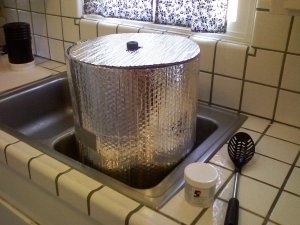I started my first batch of all grain home-brewed beer back on July 30th, and it’s fermenting in the coat closet. I’m happy with the results I’ve been getting with dry malt extract brewing, so why all grain brewing? It’s the next leg of my pilgrimage to beer knowledge. But it seemed like a big step, so I debated with myself over how to cobble together the equipment I would need for several weeks. I went to hardware stores looking for parts to assemble a copper lautering ring four times before finding a combination that looked workable at a reasonable price.
Next, it was off to Beer and Wine Makers of America for the ingredients. The proprietor asked me a series of questions to make sure I had all the stuff I needed.
“You using a double-bottomed pot for lautering?” He asks.
“No, I made a lautering manifold out of copper tubing,”
“What are you using for a mash-tun?”
“I have an eight gallon brew pot, I’ll probably use that.”
“You want a dry brew or more estery?”
“Let’s say dry.” I said.
“You’ll need to insulate it to hold the mash at 150 degrees. At 158 degrees, you get more esters.”
(I think that means you get more sugars that don’t convert to alcohol at higher mashing temperatures.)
And on it went down the list, until I was walking out with the ingredients for a California Pale Ale. This is the same recipe I used for my first batch of dry malt extract beer, except that now, instead of five pounds of DME, I have ten pounds of malted barley. He said he doubled the barley because this was my first attempt at all grain brewing, and I might only get half the usual yield on the first attempt.
“If it goes well, you’ll just have a strong brew, if not, you’ll still have something worth drinking.”
Next, I went back to the hardware store and bought some heater duct insulating material to insulate my brew pot and make it a mash tun. I’d been thinking of leaving the pot on the stove and tweaking the knobs to keep the thermometer at 150, but after listening to him explain what was required, I decided I needed to insulate my pot and remove it from the heat to hold it at 150 degrees for an hour. Maybe if I had an automated system for controlling temperature I would use active heating, but me tweaking the stove isn’t that accurate.
I also consulted the often-mentioned Charlie Papazian book, and learned that I needed about 2.75 gallons of water to make my mash with eleven pounds of grain (the ten mentioned earlier and one pound of crystal malt). The plan was to heat the water to 172, and according to Papazian, that would get me back to about a 153-degree mash temperature when I added the grain at room temperature. (Did I mention I changed my mind about the dry recipe? I’m a temperamental artist.) But I made at least one mistake (but you knew that would happen right? I am a beginner). I heated the water in a 4 gallon soup pot, then poured in my 8 gallon mash tun, then threw in the grain, and, finally, the thermometer. The temperature was only about 140 degrees.
I’m guessing that my room-temperature mash tun absorbed a bunch of the heat of the mash water. Next time I’ll heat my water in the mash tun so that the tun is at 170 degrees when i throw the grain in. Now I know. I heated some more water to almost boiling and added a bit at a time trying to hit 153 degrees. I think I overshot to about 156, but it was still in the range of 150 to 158 necessary to convert the grain into fermentable sugars. I found that I needed to add water, stir, then check the temperature. I left the thermometer in the pot the whole time, and let it mash for an hour, taking the lid off to make sure I was above 150 three times.
I transferred to the secondary fermenter last night, and at this point, I think I have a successful batch. I’m a little concerned because the bittering hops are very strong. I like a lot of aroma hops, but not too much bittering. But then, beers evolve quickly at this age. It will be very different in four weeks. I caught some woodsy-hop aromas as I started the siphon, but I noticed the smell of the malty sweetness much more when I drank the gravity sample. The original gravity was 1.050 and the gravity last night was 1.004, so that’s plenty of converted sugars. I’ll have to write another blog post to run down the recipe. So far, it’s looking good.



Perky Pear Blonde Ale 2012 « Man Seeks Beer said,
September 6, 2012 @ 10:35 pm
[…] foray into all-grain brewing. Of course, being still about a week away from the first taste of my first all-grain batch, I might still be doing this totally […]